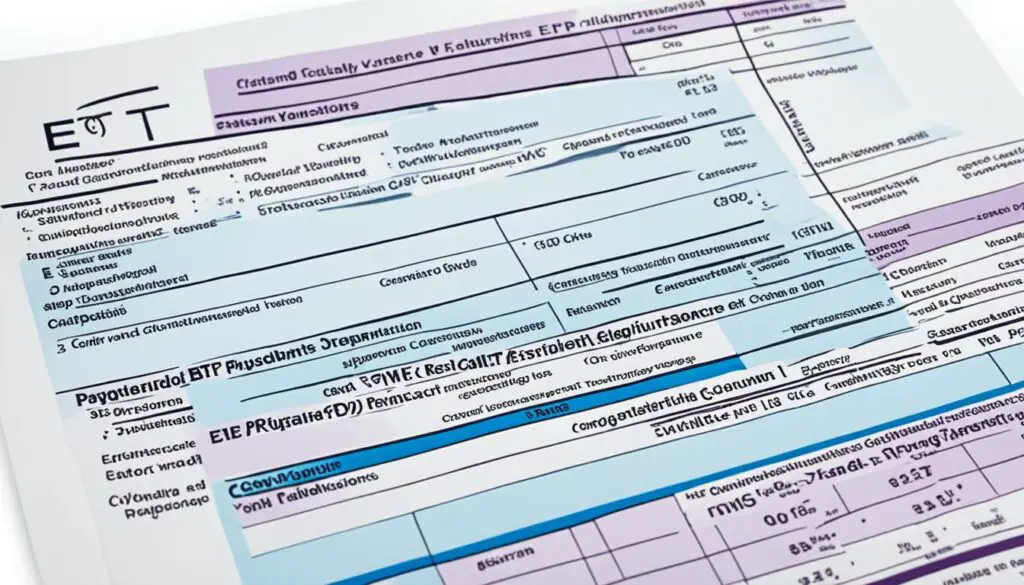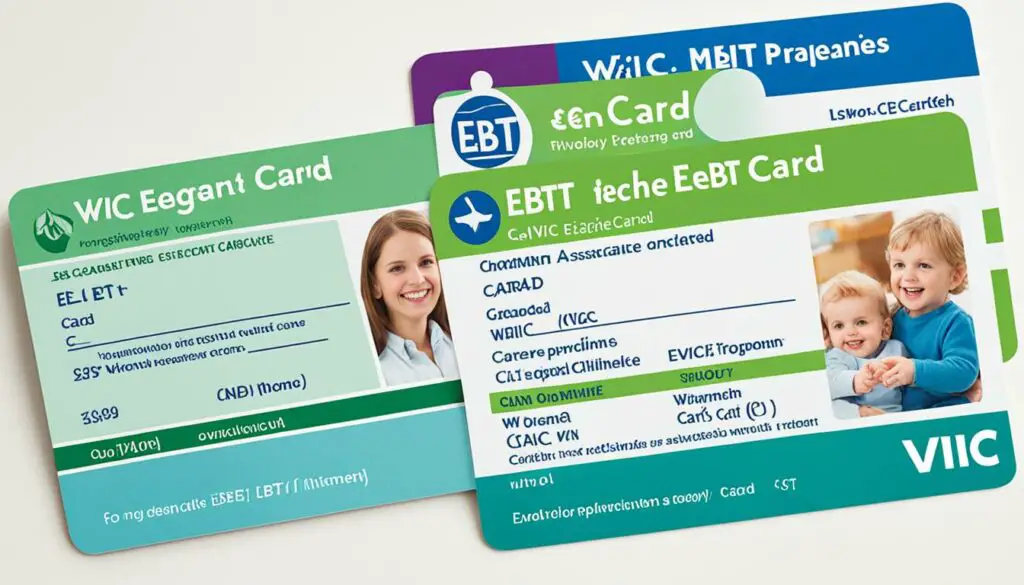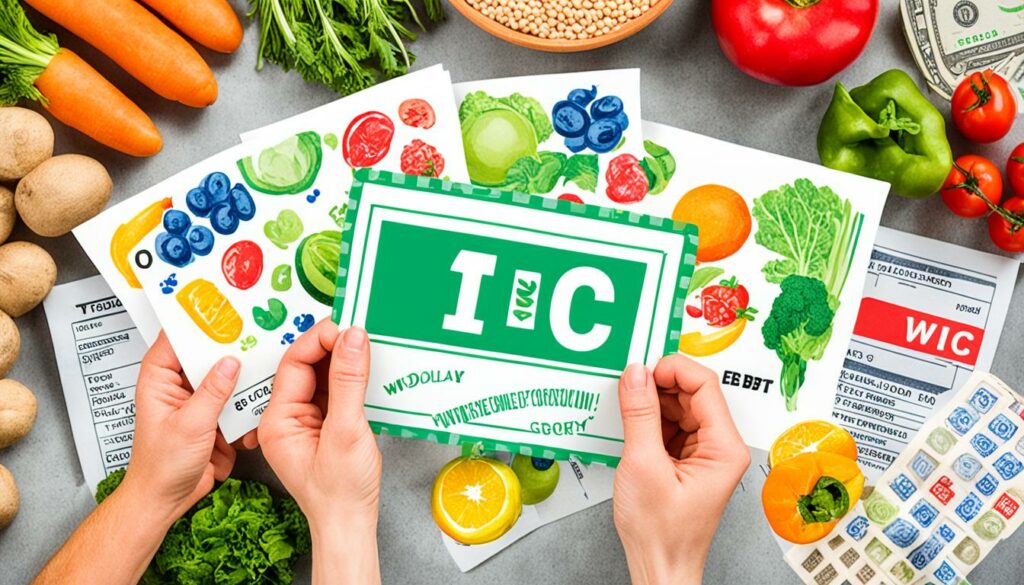Originally posted on February 10, 2024 @ 6:00 pm
The Supplemental Nutrition Assistance Program (SNAP) and the Special Supplemental Nutrition Program for Women, Infants and Children (WIC) are federally funded health and nutrition programs. While they both provide assistance to low-income families, SNAP and WIC are not the same program.
SNAP offers a monthly dollar amount on an Electronic Benefits Transfer (EBT) card for purchasing food, based on household income. In contrast, WIC provides nutrition education, breastfeeding support, referrals, and specific food items based on the individual’s situation (pregnant, breastfeeding, postpartum, or with an infant or child). WIC recipients receive a WIC card, which is used similarly to a debit or credit card. It is possible to be eligible for benefits from both SNAP and WIC simultaneously.
Table of Contents
Key Takeaways
- EBT and WIC are federally funded health and nutrition programs.
- SNAP provides a monthly dollar amount on an EBT card for purchasing food, while WIC provides specific food items and additional services.
- Eligibility for both programs is determined based on income and specific criteria related to pregnancy, breastfeeding, or having a child under five.
- Applications for SNAP and WIC benefits are managed by state agencies.
- Understanding the differences and similarities between EBT and WIC can help individuals determine which program best suits their needs.
EBT vs WIC: Key Differences and Benefits

When comparing EBT and WIC, it’s important to understand their differences in terms of benefits provided, eligibility requirements, and how they help low-income individuals and families. Let’s take a closer look at each program:
EBT (Electronic Benefits Transfer) through SNAP: SNAP offers a monthly dollar amount on an EBT card, which functions like a debit card. This card can be used to purchase a wide variety of food items from authorized retailers. The amount loaded onto the card is determined based on the household income and size. It provides families with the flexibility to choose the food items they need while managing their budget.
WIC (Special Supplemental Nutrition Program for Women, Infants, and Children): Unlike EBT, WIC does not provide a dollar amount on a card. Instead, it offers specific food items chosen based on nutritional value and USDA standards. WIC recipients receive a WIC card that allows them to purchase approved items such as fruits, vegetables, whole grains, dairy products, and more. Additionally, WIC offers nutrition education, breastfeeding support, and referrals to other health and social services.
While both EBT and WIC aim to assist low-income individuals and families in accessing nutritious food, they have distinct approaches. EBT provides the flexibility to purchase a range of food items, whereas WIC focuses on providing specific, nutritionally balanced options. This difference in benefits caters to diverse needs within the target population.
Furthermore, eligibility requirements for EBT and WIC differ slightly:
| EBT (SNAP) | WIC |
|---|---|
| Based on household income | Based on income and specific criteria related to pregnancy, breastfeeding, or having a child under five |
| No participating age restrictions | Primarily focuses on women, infants, and children |
By understanding the differences between EBT and WIC, individuals can make informed decisions about which program may best suit their needs. It’s important to note that it is possible to be eligible for benefits from both EBT and WIC if the criteria for both programs are met.
Eligibility Requirements for SNAP and WIC

If you’re considering applying for SNAP or WIC benefits, it’s important to understand the eligibility requirements for each program. Meeting these requirements will determine if you qualify for assistance. Here’s what you need to know:
SNAP Eligibility Requirements
In order to be eligible for SNAP benefits, individuals must:
- Apply in the state they currently live in
- Meet certain bank balance limits
- Note: Elderly or disabled households may have higher limits
SNAP eligibility is primarily based on income and household size. Each state sets its own income limits, which are based on a percentage of the federal poverty line. It’s important to check the specific guidelines for your state to determine if you meet the income requirements.
WIC Eligibility Requirements
To be eligible for WIC benefits, individuals must:
- Apply in the state they live in
- Be pregnant, breastfeeding, postpartum, or have a child under five
- Note: Eligibility for WIC can also be automatic if the individual or their family already receives other benefits like Medicaid or TANF
WIC eligibility is also based on income and specific criteria related to pregnancy, breastfeeding, or having a child under five. The income limits for WIC are set by the state agency and may vary depending on the state you live in. If you or your family already receive other government assistance programs, you may automatically meet the income eligibility requirements for WIC.
Understanding and meeting these eligibility requirements is crucial when applying for SNAP and WIC benefits. It ensures that the assistance goes to those who truly need it and helps provide access to nutritious food and other supportive services.
| Program | Eligibility Requirements |
|---|---|
| Snap | – Apply in the state you currently live in |
| – Meet certain bank balance limits | |
| – Elderly or disabled households may have higher limits | |
| WIC | – Apply in the state you live in |
| – Be pregnant, breastfeeding, postpartum, or have a child under five | |
| – Eligibility can be automatic if receiving other benefits |
How to Apply for SNAP and WIC

Applications for both SNAP and WIC are managed by state agencies. Each state has its own application process, which may include in-person, online, or mail applications.
To apply for SNAP, individuals can find their state agency through the Food and Nutrition Service’s state locator map. For WIC, individuals can find their state’s program contact or website from the WIC Directory.
Applying for these programs is a straightforward process, and the state agencies are there to help individuals navigate through it. Below is a table summarizing the application methods for SNAP and WIC in different states:
| State | SNAP Application Method | WIC Application Method |
|---|---|---|
| California | Online or in-person | Online or phone |
| Texas | Online, in-person, or by mail | In-person or by mail |
| New York | Online or in-person | Online, in-person, or by mail |
| Florida | Online | In-person or by mail |
Remember, each state may have its own specific requirements, so it’s important to check with the appropriate agency for accurate and up-to-date information.
Applying for SNAP and WIC can provide individuals and families with much-needed assistance for their nutritional needs. By understanding the application process and requirements, individuals can easily access these beneficial programs.
Services Provided by SNAP and WIC

SNAP and WIC offer essential services to individuals and families in need, providing assistance in different ways.
Supplemental Nutrition Assistance Program (SNAP)
SNAP provides qualifying participants with an EBT card that is loaded with a certain dollar amount each month. This EBT card functions like a debit card and can be used to purchase a wide range of food items such as:
- Fruits and vegetables
- Meat and poultry
- Dairy products
- Grains and cereals
- Non-alcoholic beverages
This program offers flexibility in food choices, allowing individuals to meet their specific dietary needs.
“The SNAP program provides financial support to buy nutritious food, empowering individuals to make meaningful choices for their well-being and overall health,” says Lisa Johnson, a SNAP program coordinator.
Special Supplemental Nutrition Program for Women, Infants, and Children (WIC)
WIC focuses on the nutritional needs of pregnant women, new mothers, infants, and young children. In addition to providing specific approved food items, WIC offers a comprehensive range of services, including:
- Nutrition education: WIC participants receive guidance on healthy eating habits, meal planning, and the importance of balanced nutrition.
- Breastfeeding support: WIC promotes and supports breastfeeding, providing lactation counseling and resources to help women successfully breastfeed their infants.
- Referrals: WIC connects participants with community resources, such as healthcare providers, social services, and other programs that support overall well-being.
“WIC not only ensures access to healthy food options but also provides education and support to empower individuals and families to make healthier choices,” explains Jennifer Martinez, a WIC coordinator.
Both SNAP and WIC play vital roles in improving food security and enhancing the overall health of low-income individuals and families. By addressing nutritional needs and offering additional services, these programs aim to create a healthier and more resilient community.
SNAP vs WIC Services
| Services Provided | SNAP | WIC |
|---|---|---|
| Food Assistance | Certain dollar amount loaded onto an EBT card each month for a variety of food items. | Specific approved food items provided, based on individual needs and nutritional requirements. |
| Nutrition Education | Not directly provided | Extensive education on healthy eating habits, meal planning, and the importance of balanced nutrition. |
| Breastfeeding Support | Not directly provided | Lactation counseling, resources, and support to promote successful breastfeeding. |
| Referrals | Not directly provided | Connections to community resources, such as healthcare providers, social services, and other programs. |
SNAP and WIC: Eligibility Comparison

Both SNAP and WIC are programs that aim to provide assistance to low-income individuals and families. Although their primary goal is similar, there are distinct differences in their eligibility requirements.
Snap eligibility is primarily based on income and household size. Individuals or families must meet specific income guidelines to qualify for benefits. The household size determines the maximum income limit for eligibility. On the other hand, WIC eligibility is based on various criteria related to pregnancy, breastfeeding, or having a child under the age of five.
If an individual meets the eligibility criteria for both SNAP and WIC, they can receive benefits from both programs concurrently. This dual benefit can help alleviate financial strains and ensure access to essential nutritional resources.
By comparing the eligibility requirements of SNAP and WIC, individuals can determine which program aligns best with their specific situation and needs.
Understanding EBT and WIC Cards

When it comes to accessing food assistance, both EBT and WIC cards play a vital role in helping eligible individuals and families. While these cards have similarities, they also have distinct differences in how they are used and where they can be used.
EBT Card:
An EBT card, short for Electronic Benefits Transfer, is used to distribute benefits under the Supplemental Nutrition Assistance Program (SNAP). This card works similarly to a debit card and is loaded with a monthly dollar amount based on a household’s income. With an EBT card, individuals can purchase a wide range of food items, including groceries, fresh produce, dairy products, meat, and non-alcoholic beverages.
WIC Card:
On the other hand, the WIC program, or Special Supplemental Nutrition Program for Women, Infants, and Children, provides assistance to individuals who are pregnant, breastfeeding, postpartum, or have children under the age of five. WIC benefits are distributed through a WIC card, which is utilized exclusively for purchasing specific approved food items such as infant formula, cereal, milk, fruits, vegetables, and whole grains. This card functions similarly to a debit card and can only be used at authorized WIC grocery stores.
It is important to note that while EBT cards can be used anywhere that accepts debit or credit cards, WIC cards are restricted to designated WIC grocery stores. This limitation ensures that WIC recipients have access to the specific foods that meet the program’s nutritional standards.
Determining Income Eligibility for SNAP and WIC

When it comes to determining eligibility for SNAP and WIC, both programs consider income as an important factor. Let’s take a closer look at how income requirements are assessed for each program.
SNAP Income Eligibility
SNAP eligibility is determined by the state agency based on both gross and net income. Gross income includes all income before deductions, while net income takes into account certain deductions allowed by the program. These deductions may include housing costs, dependent care expenses, and medical expenses for elderly or disabled household members.
To qualify for SNAP, your income cannot exceed a certain percentage of the federal poverty line. The specific income limits vary depending on factors such as household size and state of residence. It’s important to check with your state’s SNAP agency for the most up-to-date income guidelines.
For example, let’s say you live in a household of four people. The maximum gross income to qualify for SNAP would typically be higher than the net income due to the deductions allowed. Here’s a simplified table showing a general range of income limits for households of different sizes:
| Household Size | Maximum Gross Monthly Income |
|---|---|
| 1 | $1,354 |
| 2 | $1,832 |
| 3 | $2,311 |
| 4 | $2,790 |
Please note that these figures are for illustrative purposes only and may not reflect the current income limits in your state.
WIC Income Eligibility
WIC eligibility is also based on income, but the specific income level is set by the state agency. Each state determines its own income guidelines for the WIC program. These guidelines take into account the size of the household and the income of all family members.
In addition to the income requirements, WIC also considers other factors such as pregnancy, breastfeeding, or having a child under the age of five. Automatic eligibility for WIC may be granted if the individual or their family already receives certain government assistance programs, such as Medicaid or Temporary Assistance for Needy Families (TANF).
Here’s an example of the income guidelines for WIC eligibility in a hypothetical state:
| Household Size | Maximum Monthly Income |
|---|---|
| 1 | $1,968 |
| 2 | $2,658 |
| 3 | $3,349 |
| 4 | $4,039 |
Again, please note that these figures are for illustrative purposes and may not represent the current income limits in your state.
Understanding the income eligibility requirements for SNAP and WIC is crucial for determining your eligibility and receiving the necessary assistance for you and your family. Be sure to consult your state’s SNAP and WIC agencies to get accurate and up-to-date information on income guidelines and the application process.
Benefits of SNAP and WIC Programs
The SNAP and WIC programs provide essential assistance to low-income individuals and families, with a focus on improving access to nutritious food and promoting overall health and well-being.
SNAP Benefits:
The SNAP program offers a significant benefit by providing a monthly dollar amount on an Electronic Benefits Transfer (EBT) card. This allows recipients to purchase a wide variety of food items from authorized retailers. With SNAP benefits, individuals and families can choose the food items that best meet their dietary needs and preferences, ensuring that they have access to essential nutrition.
WIC Benefits:
WIC, on the other hand, goes beyond providing specific food items. In addition to the WIC card, which can be used to access approved food items, WIC offers a range of additional benefits. These include nutrition education, which equips individuals and families with the knowledge and skills to make healthy food choices. WIC also provides breastfeeding support to encourage and assist mothers in their breastfeeding journey. Additionally, WIC offers referrals to other healthcare and social services, ensuring that recipients have access to comprehensive support.
“Both SNAP and WIC play a crucial role in supporting low-income individuals and families, ensuring that they have the resources and knowledge needed to lead healthy lives.”
Common Goals:
Both SNAP and WIC programs share a common goal of improving the health and well-being of low-income individuals and families. By providing assistance for purchasing food and offering additional support services, these programs aim to alleviate food insecurity and promote positive nutritional outcomes.
Applying for SNAP and WIC Benefits
Applying for SNAP and WIC benefits is a straightforward process that is managed by state agencies. To begin the application process, individuals can find their state agency through the directories provided by the USDA. Each state may have slightly different application processes, so it’s important to refer to the specific information provided by your state agency.
When applying for SNAP and WIC benefits, individuals may need to provide certain documentation to support their eligibility. This can include proof of income, identification, residency, and other relevant documents. It’s essential to gather all the necessary paperwork in advance to ensure a smooth application process.
Remember, the application process may vary depending on the state you reside in. Here are a few general steps to keep in mind when applying for SNAP and WIC benefits:
- Contact your state agency: Use the directories provided by the USDA to find the contact information for your state agency.
- Get the application form: Request the SNAP or WIC application form from your state agency. Some states may provide online applications, while others may require in-person or mail submissions.
- Complete the application: Fill out the application form accurately, providing all the requested information. Make sure to double-check for any missing or incomplete details.
- Attach supporting documents: Gather the necessary documentation, such as proof of income, identification, residency, and any other required paperwork. Make copies of these documents and attach them to your application.
- Submit the application: Follow the instructions provided by your state agency to submit your application. This may include mailing it to a specified address, submitting it online, or visiting an office in person.
- Follow up on your application: After submitting your application, it’s essential to keep track of its status. Your state agency may provide a timeline for processing applications, and you can contact them for updates if needed.
By following these steps and providing the necessary documentation, you can ensure that your application for SNAP and WIC benefits is processed smoothly and efficiently.
“Applying for SNAP and WIC benefits is an important step towards accessing essential nutritional support. By providing the necessary documentation and following the application process outlined by your state agency, you can ensure that you receive the benefits you are eligible for.”
Conclusion
In conclusion, the Electronic Benefits Transfer (EBT) and Women, Infants, and Children (WIC) programs are valuable resources that aim to improve the health and well-being of low-income individuals and families. While both programs provide assistance, they differ in the benefits offered, eligibility requirements, and application processes.
SNAP, through EBT, provides a monthly dollar amount that can be used to purchase a variety of food items, based on household income. On the other hand, WIC offers specific approved food items, nutrition education, breastfeeding support, and referrals to other services.
It is important for individuals to understand the differences between EBT and WIC in order to make informed decisions about which program best suits their needs. They may be eligible for benefits from both programs simultaneously, as eligibility criteria vary for each program.
By understanding the benefits, eligibility requirements, and application processes of EBT and WIC, individuals can access the support they need to improve their nutritional intake and overall well-being.
FAQ
Is EBT and WIC the same thing?
No, EBT (Electronic Benefits Transfer) and WIC (Special Supplemental Nutrition Program for Women, Infants, and Children) are not the same program.
What are the differences between EBT and WIC?
EBT offers a monthly dollar amount on an EBT card for purchasing food, while WIC provides specific food items based on the individual’s situation and additional services like nutrition education and breastfeeding support.
What are the eligibility requirements for EBT and WIC?
Eligibility for EBT and WIC is determined based on income and specific criteria related to pregnancy, breastfeeding, or having a child under five.
How do I apply for EBT and WIC?
Applications for EBT and WIC benefits are managed by state agencies, and each state has its own application process. Individuals can find their state agency through specific directories provided by the USDA.
What services do SNAP and WIC provide?
SNAP provides a monthly dollar amount for food purchases, while WIC offers nutrition education, breastfeeding support, and referrals in addition to specific food items.
What similarities are there between SNAP and WIC?
Both SNAP and WIC aim to serve low-income individuals and families, and it is possible to be eligible for benefits from both programs.
How do EBT and WIC cards work?
EBT cards for SNAP work like debit or credit cards and can be used to purchase food items at participating stores. WIC cards authorize the purchase of specific approved food items and are used in authorized WIC grocery stores.
How is income eligibility determined for SNAP and WIC?
SNAP eligibility is determined by the state agency based on income, while WIC eligibility is also based on income with the level set by the state agency.
What are the benefits of SNAP and WIC programs?
SNAP provides a monthly dollar amount for food purchases, helping low-income individuals and families access nutritious food. WIC benefits also include specific food items, nutrition education, breastfeeding support, and referrals.
How can I apply for SNAP and WIC benefits?
Applications for SNAP and WIC benefits are handled by state agencies. Individuals can find their state agency through specific directories provided by the USDA.
Source Links
- https://www.benefits.gov/news/article/439
- https://www.fool.com/the-ascent/personal-finance/articles/wic-vs-snap-whats-the-difference/
- https://finance.yahoo.com/news/difference-between-snap-wic-apply-182811050.html
See also:
Leave a Reply